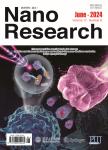Polydopamine-coated photoautotrophic bacteria for improving extracellular electron transfer in living photovoltaics
作者机构:Institute of Chemical Sciences and Engineering(ISIC)Ecole Polytechnique Fédérale de Lausanne(EPFL)Lausanne 1015Switzerland Department of Biology and Biotechnology Charles DarwinSapienza University of RomeRome 00185Italy Research Center on Nanotechnology Applied for Engineering of Sapienza(CNIS)University of Rome SapienzaRome 00185Italy CNR-IPCF Consiglio Nazionale delle Ricerche–Istituto per i Processi Chimico FisiciBari 70126Italy Institute of Life TechnologiesHES-SO Valais-WallisSion 1950Switzerland Institute for Renewable EnergyHES-SO Valais-WallisSion 1950Switzerland
出 版 物:《Nano Research》 (纳米研究(英文版))
年 卷 期:2024年第17卷第2期
页 面:866-874页
核心收录:
学科分类:0831[工学-生物医学工程(可授工学、理学、医学学位)] 08[工学] 0805[工学-材料科学与工程(可授工学、理学学位)] 0703[理学-化学] 0702[理学-物理学]
基 金:support from the Swiss National Science Foundation(Sinergia Project No.IZLIZ2_182972).
主 题:biophotovoltaics bioelectronics photosynthetic bacteria cyanobacteria polydopamine adherence
摘 要:Living photovoltaics are microbial electrochemical devices that use whole cell–electrode interactions to convert solar energy to electricity.The bottleneck in these technologies is the limited electron transfer between the microbe and the electrode surface.This study focuses on enhancing this transfer by engineering a polydopamine(PDA)coating on the outer membrane of the photosynthetic microbe Synechocystis sp.PCC6803.This coating provides a conductive nanoparticle shell to increase electrode adhesion and improve microbial charge extraction.A combination of scanning electron microscopy(SEM),transmission electron microscopy(TEM),UV–Vis absorption,and Raman spectroscopy measurements were used to characterize the nanoparticle shell under various synthesis conditions.The cell viability and activity were further assessed through oxygen evolution,growth curve,and confocal fluorescence microscopy measurements.The results show sustained cell growth and detectable PDA surface coverage under slightly alkaline conditions(pH 7.5)and at low initial dopamine(DA)concentrations(1 mM).The exoelectrogenicity of the cells prepared under these conditions was also characterized through cyclic voltammetry(CV)and chronoamperometry(CA).The measurements show a three-fold enhancement in the photocurrent at an applied bias of 0.3 V(vs.Ag/AgCl[3 M KCl])compared to non-coated cells.This study thus lays the framework for engineering the next generation of living photovoltaics with improved performances using biosynthetic electrodes.



